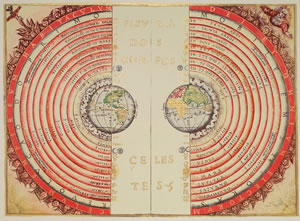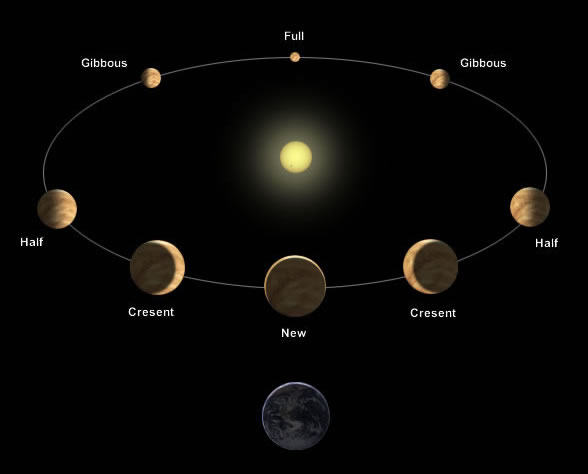
:: Venus ::
Finding Venus
Of all of the planets in our solar system Venus is the easiest to find. Venus begins the year as the evening star. You will see it high in the western sky at sunset. It says in the evening sky until late March when it will disappear completely as it passes between the Earth and the Sun. In early April Venus will start to appear in the morning sky and will stay there until December.
History and Venus
Often referred to as the morning star and evening star, Venus glitters like a jewel in the sky. Because of its beauty, the Romans named it Venus after the Roman goddess of love and beauty.
Prior to 1610 it was widely believed that the Earth was the center of the universe and that the Sun and all of the planets revolved around it. This belief is commonly referred to as the Ptolemaic worldview or the geocentric model.

Illustration of the Ptolemaic worldview by Bartolomeu Velho in 1568, Click to enlarge
In 1610, Galileo first observed the phases of Venus (similar to the lunar phases).
This discovery proved that the Sun did not orbit the Earth but in fact the Earth orbited the Sun!.

About Venus
Venus is often referred to as Earth's sister planet. It is of a similar size, mass and composition but there the similarities end.
Venus is a searing hot planet covered in a thick blanket of fast moving toxic clouds. These clouds are composed of sulfuric acid and are many miles thick, which is why we cannot see the
surface of Venus.
The surface of Venus is so hot that it would melt lead. If you were to stand on Venus the presure would be the same as if you were half a mile under the sea.
The reason for Venus being so hot is because of the atmosphere. It is mostly made up of carbon dioxide which produces a run-away green-house
effect.
:: Facts ::
1 Venusian day = 243 earth days
1 Venusian year is only 225 earth days! That means that 1 day last more than a year on Venus
Orbits the Sun every 225 earth days
Distance from the sun: 67.23 million miles
The average temperature is 482°C (900°F)
Mercury is only 5% of the Earth's mass
Venus spins slowly retrograde. This means it spins the opposite direction to earth. The Sun rises in the west and sets in the east on Venus